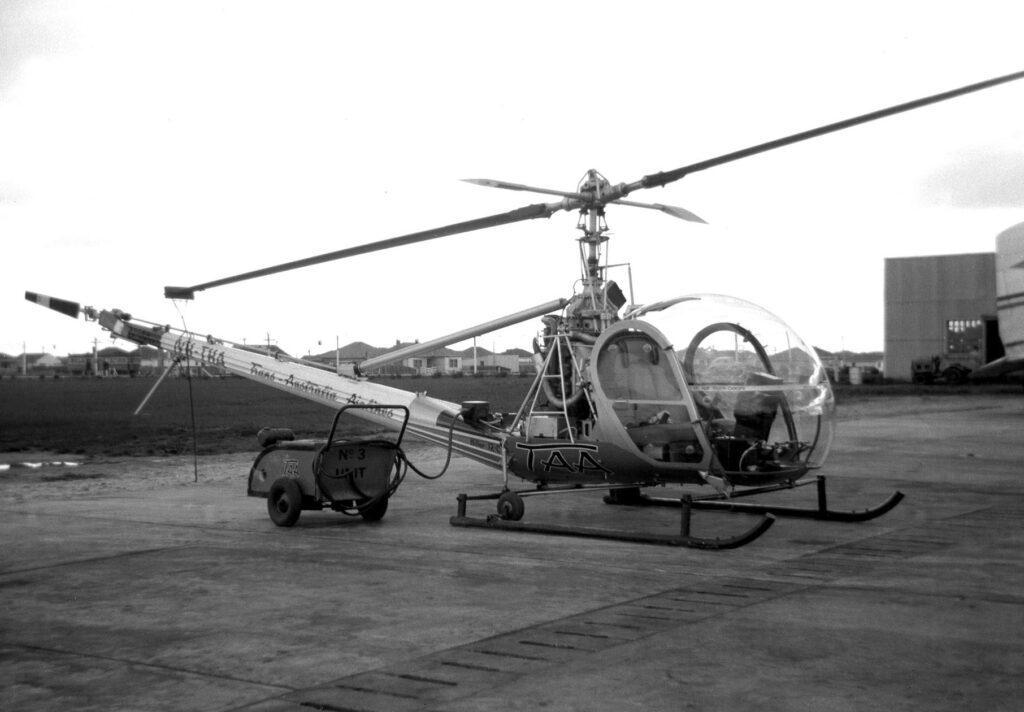TAA Helicopters on Ice
TRANS-AUSTRALIA AIRLINES – HELICOPTER OPERATIONS IN THE ANTARCTIC
(The following is an excerpt from the recollections of TAA Captain Peter Ivanoff who held one of Australia’s first commercial helicopter licences. His complete story was provided to the TAA/Australian Airlines Museum and is available on request)
Trans-Australia Airlines (TAA) was the first commercial helicopter operator in Australia when it commenced operations in 1956 using the Hiller 12C model helicopter.
Compared to the modern helicopter, the Hiller 12C was underpowered, range limited, and initially prone to frequent mechanical failure – most pilots quickly became experts at emergency procedures and forced landings.
During those early pioneering days helicopters were chartered almost exclusively by organizations involved with national development projects, such as survey mapping and exploration.
One of the original charterers was the Australian National Antarctic Research Expedition (ANARE) who trialled a TAA Hiller helicopter on the 1958 expedition to Macquarie Island. Even with the abovementioned performance limitations the operation was judged a success, and it was decided that two helicopters would be used the following summer on the Antarctic continent.
In January 1960 two Hiller helicopters (registrations VH-THB and VH-THC) were loaded aboard the MV Magga Dan on its resupply and summer survey voyage to Antarctica.
The helicopters were flown by Captain Ray Hudson, the then TAA Superintendent of Helicopters and Captain Peter Ivanoff.
A float/ski equipped DeHavilland Beaver aircraft was also loaded on board and this was to be used mainly for aerial photography.
Operating in the Antarctic was particularly challenging due to the isolation, inaccessibility, rugged landscapes, low temperatures and high winds. It was important to make the operations as safe as possible with particular emphasis on survival following any emergency forced landings on land or water.
Hence the operational policy involved always operating the two helicopters together when away from base. When landing on the ice, one helicopter would fly close by until the second had safely landed.
Flying operations commenced on 15 January 1960 following test flights near the French base of Dumont d’Ville, and continued successfully and uneventfully for the next few weeks.
On the 13 February the two helicopters departed the Wilkes base bound for Hatch Island, some 55 nautical miles away. The purpose of the flight was to fix the position of Hatch Island by astro fix and examine the geology of the area. It was planned to refuel on both outbound flight as well as the return flight.
VH-THB was piloted by Captain Ray Hudson with passenger Ian McLeod a geologist. VH-THC was piloted by Captain Peter Ivanoff with passenger David Cook a surveyor.
Surface conditions on take-off were acceptable with light and variable winds. The flight proceeded normally except shortly after departing VH-THB suffered a generator failure. To conserve battery power, Captain Hudson switched off the long range radio. Consequently VH-THC flew in close formation to keep VH-THB in view and in turn maintain radio contact with the MV Magga Dan.
At 8:30am both helicopters landed to refuel and after departing climbed to a cruise height of 2000ft. It was apparent that both upper and surface winds were building up noticeably the further the flight progressed.
On approach to Hatch Island VH-THB descended to check surface conditions and reported severe, almost uncontrollable turbulence, and suggested diverting to the opposite side of the Hatch Island area which appeared to be slightly sheltered.
Captain Ivanoff in VH-THC approached Hatch Island and made a pass to about 300ft over a small rocky headland adjacent to a sloping ice plateau which ended at ice cliffs about 100ft high.
Wind shear was extreme and Captain Ivanoff carried out a missed approach climbing to 600ft where he caught a glimpse of VH-THB breaking left, heading towards the rocky headland and struggling to gain height.
Via short range radio contact the pilots agreed that conditions were too difficult to land and discussed abandoning the area and returning to a flat ice shelf north of the present position.
Suddenly, with increasing wind shear and severe turbulence, Captain Ivanoff and VH-TBC were forced into an emergency landing on the ice shelf.
Captain Hudson managed to land on the lee of the small headland and contacted the MV Magga Dan which prepared to leave as soon as possible.
Captain Ivanoff and David Cook, roped together, set off up the slope and made their way back to where Captain Hudson had landed and erected a survival tent. The MV Magga Dan, made extremely good time through unchartered waters arriving at 4:15 pm. The ship’s whale boat under the command of the First Officer, was launched and proceeded through the brash ice to start the rescue.
Unfortunately, in their haste, the whale boat grounded on an unseen rock 5 or 6 metres from the shore line, but fortunately on a rising tide. Whilst waiting for the tide to free the boat, medical supplies in the form of a bottle of best Danish Akvavit (a distilled spirit produced in Scandinavia) was hurled from the whale boat into waiting hands on shore.
After a salvage party climbed out to the downed helicopter it was decided that due to the precarious position of the helicopter, it to be abandon where it lay.
For the remainder of the voyage, with only one helicopter, no further long-range surveys could be carried out, but VH-THB continued to be most useful for local flights around the ship and ship to shore logistic support.
In spite of the situation helicopters had proved their worth and they became an established tool of ANARE operations for the next eight years.
(Following the formal investigation and report of the above events the rocky outcrop which provided the reference point for the rescue was named Ivanoff Head)
Details provided by the TAA/Australian Airlines Museum, 7 York Street. Airport West, VIC 3042

